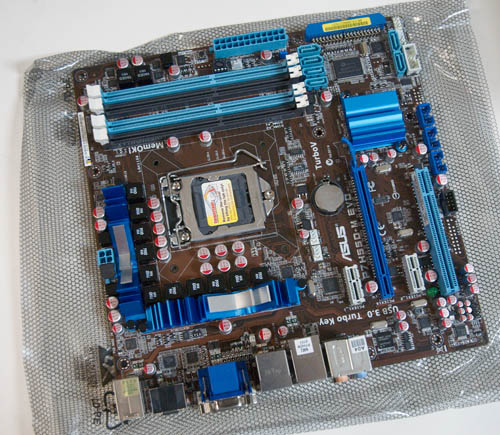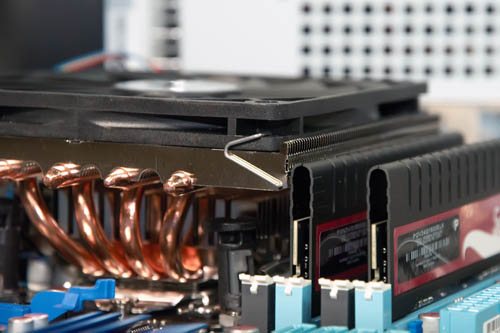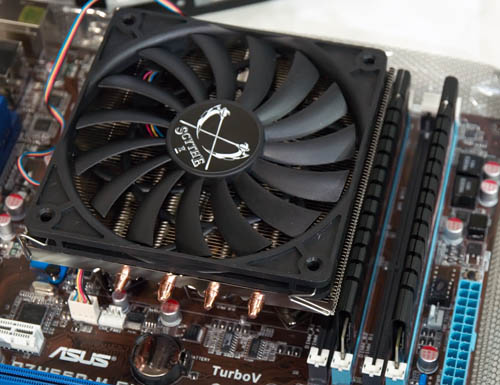The Pain of Assembly
Building a small form factor system is an exercise in flowcharts. If you’re using a highly compact case, like the Silverstone SG04B, the order of assembly is critical. The power supply, for example, goes in last.
The Asus motherboard offers a fairly clean layout, so there’s ample room for a large CPU cooler. However, I discovered late in the game that the SATA ports are poorly located, which means a long graphics card butts up to some of the SATA connectors. The board has plenty of ports, however, and does support USB 3.0, with an onboard NEC USB 3.0 controller.

Attaching the CPU cooler was challenging, too. I’ve generally liked Scythe coolers, but the designers often don’t think about how you actually mount the HSF. The Shiruken is a very low profile cooler, just 58mm high, including the skinny, 120mm fan. However, it’s fairly large, at 4.7 inches square. Plus, the Intel mounting tabs are under the radiator.
All this meant two things: I needed to install the HSF before installing the motherboard in the case.
Installing the cooler was an exercise in patience. I needed a large, flat bladed screwdriver, because there was no way I was going to get my fingers in between the HSF radiator and the top of the mounting pushpin, and still exert enough force to press the connector down until it snapped into place. Even then, I wasn’t 100% sure that all four pushpins had locked down.
And the Patriot memory modules, with their slightly taller silhouette, meant that two of the memory sockets weren’t usable. Lower profile memory modules would have allowed me to install four modules instead of two, if I wanted to go beyond 4GB.


Once the heat sink, CPU and memory were in place, the motherboard slid into the case nicely. It’s definitely a snug fit, since the case is just the right size for a micro ATX motherboard.
The biggest pain, though, was installing the Radeon HD 5850 graphics card. The XFX card is based on the reference design, and is 9.5 inches long. However, the power connectors are on the rear of the card. This had two consequences: you needed to attach the PCIe power plugs before installing the card in the case. Secondly, getting the card into the case meant slipping the card in at an angle, holding cables out of the way, and making sure you didn’t bump SATA or front panel connectors.
Due to the location of the SATA ports, I had to route the SATA cables over the top of the graphics card. Otherwise, I’d need to run them under the card, and that space is already pretty crowded.

The Silverstone case mounts hard drives in the base of the case, which is removable. However, as with the motherboard tray, space is tight, so you need to attach SATA and drive power after you close up the case bottom. I needed to be very careful, as the power adapter and SATA plug have barely enough room. It would be very easy to damage a SATA drive connector.
Once I figured out cable routing and got the graphics card running – which took several cycles of installing and removing the card, then re-routing cables – I booted the system. Everything was good. Installing Windows went smoothly.
The OCZ drive is fast, too. It’s in a 3.5-inch shell, rather than the more common 2.5 inch mechanism, and is really two 128GB modules pre-configured inside the shell for RAID 0. (Users never see the RAID configuration.)










81 Comments
View All Comments
GeorgeH - Wednesday, January 27, 2010 - link
Especially since the stated goal was low power consumption and the 750 consumes ~10W or less than the 661 at idle. He could've saved $10 and gotten a faster, more mature, more power efficient, and cheaper platform.jnmfox - Wednesday, January 27, 2010 - link
Seems like you dropped a lot to get a SFF build, but like you said the SSD was almost half the cost. I'm sure the SSD really helps with heat and noise, I love my laptop SSD for that reason.I've been looking at building a mini-ITX gaming system using the upcoming Sugo SG07, an i3 CPU, and my 4850 for the GPU. Good to read your experiences with the micro ATX build.
takumsawsherman - Wednesday, January 27, 2010 - link
I kind of get it. Vacation is fun. I don't mean the Bahamas. I mean being home with family and being able to enjoy the fruits of your labors and good fortune. You might not want to come back in a full time way, so you don't. I think that sounds like a lot of fun, and look forward to the day where I can do the same.At the same time, hiring a "Loyd" was probably a bad idea. There is no value in his writing or "experiments". I don't want to hurt the guy, it's just that Anandtech has had it's share of mediocre articles. This doesn't meet the standard of mediocre.
Between the fact that there are fewer articles posted than in years past, very few roundups with actual stability and feature testing, Anandtech is getting to be a very boring bookmark to click every day. Someone should be hired who has the time and inclination to get motherboards, memory, video cards, cases, etc., and not just test them and rave about them, but to push back on the vendors to improve them. They should be encouraged to reduce the "inspire a 14 year old" theme that they seem to embrace, and build professional products. Like Tyan used to do. Extended stability testing, checking for bugs regarding QVL memory compatibility (this has been a problem lately) and holding their warranty service to account are all things that Anand has done in the past, and should do again.
Also, Firewire should be implemented at the highest speed available (currently 800) or the motherboard should be thrown in the garbage :) I include this to let others know that I have not forgotten the true cause.
mindless1 - Saturday, January 30, 2010 - link
I'm in total agreement with the second half of what you wrote!As for the first half, the kind of articles you want have to *exist* in order to displace the articles you don't want, and you can opt not to read anything, at any time. Often I know if I want to read a complete article by the end of the first couple paragraphs if the title alone doesn't deter me.
IOW, more articles is better. So long as Loyd gets click-through there's every reason to keep articles that apparently were of interest to some readers. All visitors to AT are not hardware gurus, everyone had to start somewhere too.
blowfish - Wednesday, January 27, 2010 - link
Lloyd's component choices seem as extravagant as the recent ones he made for his teenage daughter's pc! Could it be there's a pattern developing?Without overclocking, there would seem to be no point in the 661 - so I hope there is some follow-up meat to go on the bones of this article.
stromgald30 - Wednesday, January 27, 2010 - link
As with most novice builders, he buys into a lot of the marketing and doesn't yet have the feel for balancing performance across CPU, GPU, RAM, Mobo, and hard drive so that he's not overspending in any one area.alphacheez - Wednesday, January 27, 2010 - link
Well, he's overspent on basically every component just like he said he would in the article. He's basically taken each component and taken it a step (or more) above the sweet spot of performance per dollar.I'd like to see this system compared with a system along the lines of the "budget" component suggestions he makes at the end of the article. How much more are you getting for your money? I have a feeling the expensive system won't be terribly much faster but it might enable a better experience by allowing gaming at a higher resolution and more eye candy, less slowdown when a mechanical hard drive may choke on random reads/writes, etc.
The i5-661 does seem to be an odd choice to pair with a discrete graphics card since the main benefit of the 661 over the 660 is a higher-clocked integrated GPU which would presumably also increase heat output, power consumption and noise; all things Lloyd is trying to avoid. Is there some ability to switch from the discrete GPU to the integrated CPU that might allow for some power savings when not performing demanding 3D workloads? I know there had been talk of systems along those lines earlier, but I thought those had all been discontinued (or maybe just delayed???).
I look forward to the followup to this article to see how it actually works out. I personally would get a lower performance computer closer to the $/performance optimum and use the money I saved to allow me to upgrade to a new machine (or newer components) sooner.
stromgald30 - Wednesday, January 27, 2010 - link
I think that may be worth an article. A comparison of real world performance differences between his high end system and a mid-range and budget system with the same case.The article seems well written, but there's no meat to this other than Loyd documenting his experiences. For veteran PC builders/tweakers, this isn't all to interesting, and IMHO belongs more in the forums than as an article.
pjladyfox - Wednesday, January 27, 2010 - link
I'm curious as to why you went with the Silverstone SG04B? As you pointed out space is incredibly tight in that enclosure and airflow really is restricted after you put in everything. And that's not even covering the massive cost of the case itself.Just glancing at similar cases I see there are better options:
Antec Mini P180 - $70-$80 via newegg
Thermaltake VF1000BWS Lanbox - $110 via newegg
Thermaltake LANBOX Lite VF6000BWS - $80 via newegg
All of these should have not only given you the size of case you wanted but more room and better airflow.
loydcase - Wednesday, January 27, 2010 - link
The Silverstone SG04 is easily more transportable than the cases you mention. I really wanted to squeeze this a bit. The gating factor was really the size of the graphics card more than anything else, but I wanted small, quiet and low power.